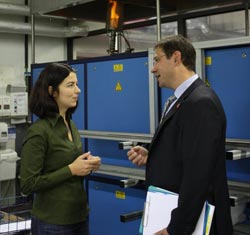Plant Optimisation Saves Energy

Dr Larisa von Riewel and Joerg Woell of the Consulting Team can often best identify optimisation opportunities for heating process directly on plant. <br>Copyright Heraeus Noblelight 2010<br>
Can the coating dry more quickly? Is it possible to reduce the rejection rate? Does the plant use too much energy?
Many companies ask themselves questions like these. Energy and material costs are important considerations for industrial companies who wish to maintain or improve their competitiveness. At the same time, the optimisation of existing plant can often be the more sensible and cost-effective option over installing new plant. A newly established consulting team at Heraeus Noblelight now offers support through individual consultancy, practical planning and prompt implementation of measures to achieve optimisation of plant, equipment and processes.
A drying oven is often the bottleneck in a production line. In order to increase production output, a convection oven can, for example, be extended – but this is not possible in every factory. It is more efficient to replace the hot air with infrared heating or to use a combination of the two technologies, which can generally lead to savings in space and energy. However, the best way is to examine the complete system. “Recently, we have carried out detailed investigations of their system technology for one of our customers using Time-Distance diagrams,” explains Joerg Woell from the new consulting division at Heraeus Noblelight.
“In doing so, we could see immediately that a conversion of the drying process would make sense.” This showed that by using fast-acting carbon infrared emitters, with electronic linking to the conveyor system, there is an optimisation of the operating life and significant energy saving. Precise calculations showed that following the conversion only 460 kW of power was required compared with the previous 880 kW.
To carry out such calculations, the new Heraeus division also used modern numerical methods such as Ray Tracing and Computational Fluid Dynamic, in addition to the usual tests in the Application Centre and the information contained in the data banks built up over years.
Identifying and Implementing Optimisation Opportunities
The new consulting team provides consultancy and advice, planning and implementation of economical energy efficiency measures. In accordance with VDI 3922, Heraeus investigates production plants for potential improvements, using a practical approach which is independent of equipment manufacturers. Tests have been carried out for many years to analyse heating processes in our in-house Application Centre and on site. Experimental data in our databases, built up over decades, has also been useful for first assessments. Now we have added modern numerical techniques. Ray Tracing and Computational Fluid Dynamics are very valuable methods, for example, for optimising the homogeneity of heating on surfaces or minimising edge zone losses.
The use of modern infrared technology together with defined process optimisation increases the degree of utilisation of the production plant. It is important to understand the heating process precisely so that infrared heat can be used “on demand”. For example, if emitters are switched on only when a product to be heated actually requires heat, then energy is saved, operating life is optimised and efficiency is increased significantly.
“In the aforementioned case, we could not only achieve 60% energy savings but also a reduction in rework rate,” enthused Joerg Woell. The measures established are evaluated in terms of economic viability to illustrate the possible energy-saving and production opportunities.
Heraeus Noblelight GmbH with its headquarters in Hanau and with subsidiaries in the USA, Great Britain, France, China, Australia and Puerto Rico, is one of the technology and market leaders in the production of specialty light sources. In 2009, Heraeus Noblelight had an annual turnover of 71.6 Million € and employed 707 people worldwide. The organisation develops, manufactures and markets infrared and ultraviolet emitters for applications in industrial manufacture, environmental protection, medicine and cosmetics, research, development and analytical laboratories.
Heraeus, the precious metals and technology group headquartered in Hanau, Germany, is a global, private company with over 155 years of tradition. Our businesses include precious metals, sensors, biomaterials and medical products, dental products, quartz glass, and specialty light sources. With product revenues of € 2.6 billion and precious metal trading revenues of € 13.6 billion, as well as more than 12,300 employees in over 110 subsidiaries worldwide, Heraeus holds a leading position in its global markets.
Further Information:
Readers:
Heraeus Noblelight GmbH
Reinhard-Heraeus-Ring 7
D-63801 Kleinostheim
Phone +49 6181/35-8545, Fax +49 6181/35-16 8545
E-Mail hng-infrared@heraeus.com
Press:
Dr. Marie-Luise Bopp
Heraeus Noblelight GmbH,
Abteilung Marketing/Werbung
Phone +49 6181/35-8547, Fax +49 6181/35-16 8547
E-Mail marie-luise.bopp@heraeus.com
Media Contact
More Information:
http://www.heraeus-noblelight.comAll latest news from the category: Power and Electrical Engineering
This topic covers issues related to energy generation, conversion, transportation and consumption and how the industry is addressing the challenge of energy efficiency in general.
innovations-report provides in-depth and informative reports and articles on subjects ranging from wind energy, fuel cell technology, solar energy, geothermal energy, petroleum, gas, nuclear engineering, alternative energy and energy efficiency to fusion, hydrogen and superconductor technologies.
Newest articles

Properties of new materials for microchips
… can now be measured well. Reseachers of Delft University of Technology demonstrated measuring performance properties of ultrathin silicon membranes. Making ever smaller and more powerful chips requires new ultrathin…

Floating solar’s potential
… to support sustainable development by addressing climate, water, and energy goals holistically. A new study published this week in Nature Energy raises the potential for floating solar photovoltaics (FPV)…

Skyrmions move at record speeds
… a step towards the computing of the future. An international research team led by scientists from the CNRS1 has discovered that the magnetic nanobubbles2 known as skyrmions can be…





















